Related Research Articles

Timely Comics is the common name for the group of corporations that was the earliest comic book arm of American publisher Martin Goodman, and the entity that would evolve by the 1960s to become Marvel Comics.

Western Gunfighters is the name of two American Western-anthology comic book series published by Marvel Comics and its 1950s forerunner, Atlas Comics.
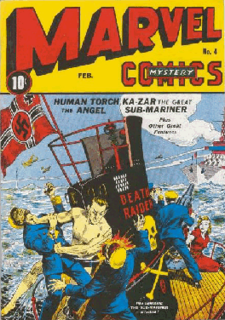
Marvel Mystery Comics is an American comic book series published during the 1930s–1940s period known to fans and historians as the Golden Age of Comic Books. It was the first publication of Marvel Comics' predecessor, Timely Comics, a division of Timely Publications.

Dylan Horrocks is a cartoonist best known for his graphic novel Hicksville and his scripts for the Batgirl comic book series.

Atlas Comics is the 1950s comic-book publishing label that evolved into Marvel Comics. Magazine and paperback novel publisher Martin Goodman, whose business strategy involved having a multitude of corporate entities, used Atlas as the umbrella name for his comic-book division during this time. Atlas evolved out of Goodman's 1940s comic-book division, Timely Comics, and was located on the 14th floor of the Empire State Building. This company is distinct from the 1970s comic-book company, also founded by Goodman, that is known as Atlas/Seaboard Comics.

Millie the Model was Marvel Comics' longest-running humor title, first published by the company's 1940s predecessor, Timely Comics, and continuing through its 1950s forerunner, Atlas Comics, to 1970s Marvel.

The Ringo Kid is a fictional Western hero in the Marvel Comics' universe, whose comic book series was originally released by the company's 1950s predecessor, Atlas Comics. A lesser-known character than the company's Kid Colt, Rawhide Kid, or Two-Gun Kid, he also appeared in a reprint series in the 1970s.
The Holyoke Publishing Company was an American magazine and comic-book publisher with offices in Holyoke, and Springfield, Massachusetts, and New York City, Its best-known comics characters were Blue Beetle and the superhero duo Cat-Man and Kitten, all inherited from defunct former clients of Holyoke's printing business.
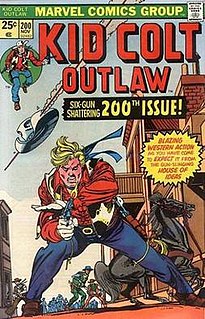
Kid Colt, Outlaw is a comic book title featuring the character Kid Colt originally published by Atlas Comics beginning in 1948 and later Marvel Comics.
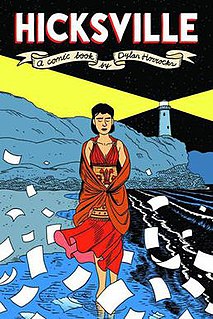
Hicksville is a graphic novel by Dylan Horrocks originally published by Black Eye Comics in 1998. The novel explores the machinations of the comic book industry, and contains a slightly fictionalized account of the history of mainstream American comics, with particular attention paid to the era of Image Comics.
Mystic Comics is the name of three comic book series published by the company that eventually became Marvel Comics. The first two series were superhero anthologies published by Marvel's 1930-1940s predecessor, Timely Comics, during what fans and historians call the Golden Age of comic books. The third, simply titled Mystic, was a horror fiction-suspense anthology from Marvel's 1950s forerunner, Atlas Comics.
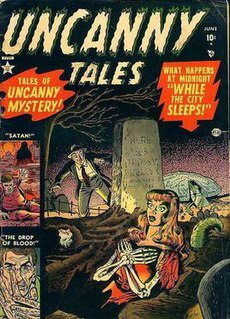
Uncanny Tales is the name of two American science-fiction / horror comic-book series, published in the 1950s and the 1970s. The first volume was by Atlas Comics, the 1950s precursor of Marvel Comics, and the second volume by Marvel. It is also the title of a British comics digest.

Black Eye Books was a short-lived but influential Canadian comic book publishing company founded by Michel Vrana. Under the auspices of Vrana, Black Eye was known as a publisher of artfully designed alternative comics and graphic novels, most of whose cartoonists have gone on to successful careers with fellow Canadian publisher Drawn & Quarterly. For several years, Vrana acted as Drawn & Quarterly's exclusive outside design consultant. In 2019 the company was relaunched as a micro-press with a focus on using crowdfunding to bring projects to fruition.
Monsters Unleashed is the title of an American black-and-white comics magazine published by Magazine Management and two color comic-book miniseries from Marvel Comics. The first ran from 1973 to 1975. The two miniseries ran consecutively in 2017.

Horror comics are comic books, graphic novels, black-and-white comics magazines, and manga focusing on horror fiction. In the US market, horror comic books reached a peak in the late 1940s through the mid-1950s, when concern over content and the imposition of the self-censorship Comics Code Authority contributed to the demise of many titles and the toning down of others. Black-and-white horror-comics magazines, which did not fall under the Code, flourished from the mid-1960s through the early 1980s from a variety of publishers. Mainstream American color comic books experienced a horror resurgence in the 1970s, following a loosening of the Code. While the genre has had greater and lesser periods of popularity, it occupies a firm niche in comics as of the 2010s.
Combat Kelly is the name of two fictional characters in comic books published by Marvel Comics. Both appear in war comics titles: Combat Kelly, published by Marvel's 1950s iteration, Atlas Comics, and set during the Korean War; and the 1970s series Combat Kelly and the Deadly Dozen, set earlier during World War II.
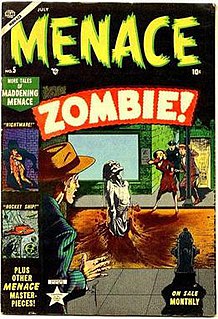
Menace was a 1953 to 1954 American crime/horror anthology comic book series published by Atlas Comics, the 1950s precursor of Marvel Comics. It is best known for the first appearance of the supernatural Marvel character the Zombie, in a standalone story that became the basis for the 1970s black-and-white comics magazine Tales of the Zombie. As well, a standalone story in the final issue introduced a robot character that was revived decades later as the Human-Robot, a.k.a. M-11, the Human-Robot.

Girl Comics is the name of two comic-book series published by Marvel Comics and its forerunners, Timely Comics and Atlas Comics. The first, debuting in 1949, ran 35 issues, changing its title to Girl Confessions with issue #13. The second was a three-issue limited series published in 2010.
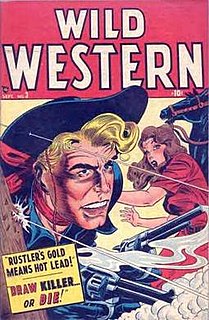
Wild Western was a Western comic book series published by Atlas Comics, the 1950s forerunner of Marvel Comics. The omnibus series published 57 issues from 1948 to 1957. Kid Colt stories were usually the lead feature and a prominent cover element throughout the series' run, while most issues also featured the Two-Gun Kid and the Black Rider. Other recurring characters included Tex Taylor, Arizona Annie, the Apache Kid, and the Ringo Kid.
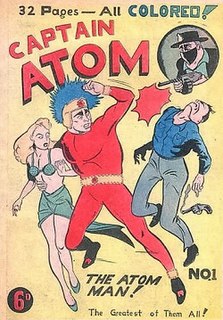
Captain Atom is an Australian comic book series created and written by Jack Bellew with illustrations by Arthur Mather. It was published from 1948 to 1954, with 64 issues and it also appeared as strips in a number of Australian newspapers. The protagonist, the first to use the name, has no relation to the later American superhero Captain Atom, published by Charlton Comics in 1965 and subsequently by DC Comics in 1987.
References
- ↑ Umile, Dominic (September 11, 2015). "Sam Zabel and the Magic Pen By Dylan Horrocks". Washington City Paper .
- ↑ Atlas entry, Grand Comics Database. Accessed Feb. 7, 2017.